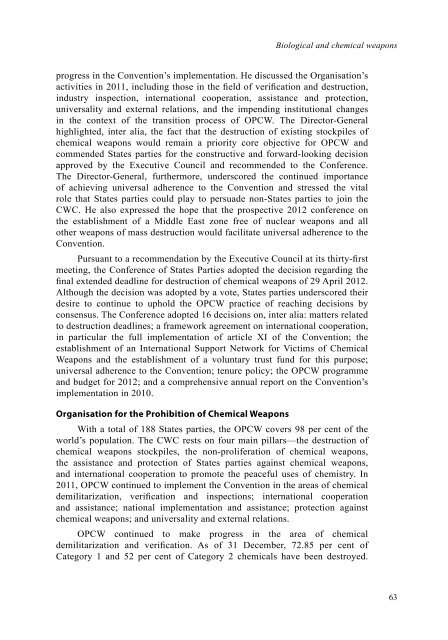DYB2011-Part-II-web
DYB2011-Part-II-web
DYB2011-Part-II-web
You also want an ePaper? Increase the reach of your titles
YUMPU automatically turns print PDFs into web optimized ePapers that Google loves.
Biological and chemical weapons<br />
progress in the Convention’s implementation. He discussed the Organisation’s<br />
activities in 2011, including those in the field of verification and destruction,<br />
industry inspection, international cooperation, assistance and protection,<br />
universality and external relations, and the impending institutional changes<br />
in the context of the transition process of OPCW. The Director-General<br />
highlighted, inter alia, the fact that the destruction of existing stockpiles of<br />
chemical weapons would remain a priority core objective for OPCW and<br />
commended States parties for the constructive and forward-looking decision<br />
approved by the Executive Council and recommended to the Conference.<br />
The Director-General, furthermore, underscored the continued importance<br />
of achieving universal adherence to the Convention and stressed the vital<br />
role that States parties could play to persuade non-States parties to join the<br />
CWC. He also expressed the hope that the prospective 2012 conference on<br />
the establishment of a Middle East zone free of nuclear weapons and all<br />
other weapons of mass destruction would facilitate universal adherence to the<br />
Convention.<br />
Pursuant to a recommendation by the Executive Council at its thirty-first<br />
meeting, the Conference of States <strong>Part</strong>ies adopted the decision regarding the<br />
final extended deadline for destruction of chemical weapons of 29 April 2012.<br />
Although the decision was adopted by a vote, States parties underscored their<br />
desire to continue to uphold the OPCW practice of reaching decisions by<br />
consensus. The Conference adopted 16 decisions on, inter alia: matters related<br />
to destruction deadlines; a framework agreement on international cooperation,<br />
in particular the full implementation of article XI of the Convention; the<br />
establishment of an International Support Network for Victims of Chemical<br />
Weapons and the establishment of a voluntary trust fund for this purpose;<br />
universal adherence to the Convention; tenure policy; the OPCW programme<br />
and budget for 2012; and a comprehensive annual report on the Convention’s<br />
implementation in 2010.<br />
Organisation for the Prohibition of Chemical Weapons<br />
With a total of 188 States parties, the OPCW covers 98 per cent of the<br />
world’s population. The CWC rests on four main pillars—the destruction of<br />
chemical weapons stockpiles, the non-proliferation of chemical weapons,<br />
the assistance and protection of States parties against chemical weapons,<br />
and international cooperation to promote the peaceful uses of chemistry. In<br />
2011, OPCW continued to implement the Convention in the areas of chemical<br />
demilitarization, verification and inspections; international cooperation<br />
and assistance; national implementation and assistance; protection against<br />
chemical weapons; and universality and external relations.<br />
OPCW continued to make progress in the area of chemical<br />
demilitarization and verification. As of 31 December, 72.85 per cent of<br />
Category 1 and 52 per cent of Category 2 chemicals have been destroyed.<br />
63


